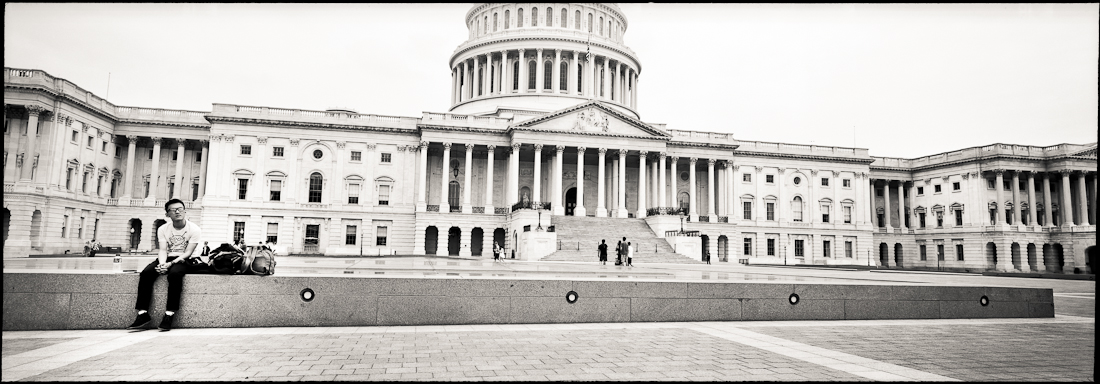Got my hands on a 617 medium format panoramic camera. Its a Gaoersi 617. Its built like a Chinese tank! Not as pretty as Linhof 617, but at 1/8th of the price do you really care?
But the glass is German, Grandagon-N 90mm 6.8. Its interchangeable with most large format lenses using their 'cones'. The camera is heavy, painfully slow to reload, and the viewfinder is not that accurate (its a 'ballpark' finder). Focusing is done by guessing the distance and turning the ring to the proper distance. You only get 4 shots per roll of 120. So most of the time you're reloading the camera... Did I tell you that its a pain to reload?
So noticing its poor handling characteristic of this camera, I thought it would be perfect for street photography. Some would say I'm smoking crack. Your typical pano shooters are obsessed with getting things leveled, and they love their tripod. I could understand why. but I wanted to use this camera in a way I wanted to. Hand-held, loose, grabbing moments with this crazy wide perspective that frames the street like a stage.
But the glass is German, Grandagon-N 90mm 6.8. Its interchangeable with most large format lenses using their 'cones'. The camera is heavy, painfully slow to reload, and the viewfinder is not that accurate (its a 'ballpark' finder). Focusing is done by guessing the distance and turning the ring to the proper distance. You only get 4 shots per roll of 120. So most of the time you're reloading the camera... Did I tell you that its a pain to reload?
So noticing its poor handling characteristic of this camera, I thought it would be perfect for street photography. Some would say I'm smoking crack. Your typical pano shooters are obsessed with getting things leveled, and they love their tripod. I could understand why. but I wanted to use this camera in a way I wanted to. Hand-held, loose, grabbing moments with this crazy wide perspective that frames the street like a stage.
Chinatown Washington D.C. Kodak TMY 400, Grandagon-N 90mm 6.8, Gaoersi 617
The biggest challenge was the focusing. Even with fairly bright conditions and fast film, I'm shooting at 500th at f11 or 8. Keep in mind that this lens is large format lens so they are pretty slow. I like to shoot with faster shutter speed since I'm moving around a lot and want to prevent shakes. Hyperfocal focusing would work if I was shooting like 125th and stopped down to f16 or something I guess, but once again, I wanted to prevent camera shakes.
Capitol BuildingWashington D.C. Kodak TMY 400, Grandagon-N 90mm 6.8, Gaoersi 617
Getting things to fit in this format is a fun challenge. You really have to use all that space, if you don't why shoot a pano?
Washington D.C. Kodak TMY 400, Grandagon-N 90mm 6.8, Gaoersi 617
This was nuts! I was reloading the camera with my head down and heard this 'clop clop clop'. I looked up and said, 'are you kidding me?' I wanted to use the pano format to get these riders in. Since I was in a hurry, I've noticed that I was framing like I was using a regular camera. So instead of shooting (and having to reload after 4 shots, daaamn!) I slowed myself down to look for a proper composition where I can justify the pano format.
Capitol Building Washington D.C. Kodak TMY 400, Grandagon-N 90mm 6.8, Gaoersi 617
Pano cameras are almost perfect for inconspicuous shooting. This kid had no idea that he was in the picture! My camera was so pointing away from him, even I had to convince myself that he's actually in the picture. As far as he was concerned I'm just another tourist shooting that building for the millionth time.
Washington D.C. Kodak TMY 400, Grandagon-N 90mm 6.8, Gaoersi 617
I was probably 15 feet away from this group of people. That big camera is pretty hard to hide. But I've learned to hide my intentions, not my camera. Hiding your intention is a psychological game that you play with your subject. You make it seem that you are photographing something else, then when the moment is right you compose and shoot. After the shot you're shooting something else again, as far as what they think. So from their perspective, 'oh this guy is taking picture of the street... wait, did he take a picture of me just now?... no I think he was shooting something else.' With smooth motions and relaxed mindset you can be invisible even with a big clunker in your hand.
Washington D.C. Kodak TMY 400, Grandagon-N 90mm 6.8, Gaoersi 617
I had so much fun shooting this thing in the street. The quiet shutter, non-blackout viewfinder, and that wide perspective, can be used very effectively in the streets. Sure it has its down side, but if you learn to get around it, it won't bother you too much. Sure changing after only 4 shots can not be overcome, but have you seen the size of the negative of 617 compared to x pan (35mm)? No contest. Stiching multiple shots with your digicam? Can't do, when things are moving. Cropping the image from your DSLR? Sure, but what's the fun in that?
I'm a believer of enjoyment is not necessarily 'easy'... This film spool is such a pain in the ass to switch over...damn it.






I have just purchased the Grandagon-N 90mm 6.8 lens with the idea of building my own 6x17 camera. Nice write up by the way thanks. ;-)
ReplyDeleteNice choice of lens! I would like to see your finished product. It would be nice if the viewfinder was more accurate on my finder. Good luck to you!
ReplyDelete